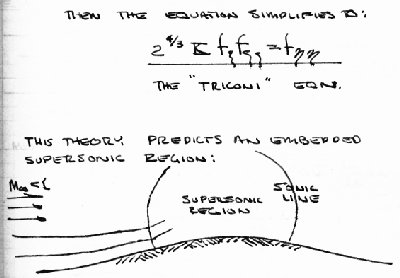Faster Than Sound
Today, the sound barrier. The University of Houston's College of Engineering presents this series about the machines that make our civilization run, and the people whose ingenuity created them.
In 1935 a British aerodynamicist showed reporters a graph of wind-tunnel results. They showed how the drag on a wing depended on the Mach Number. As the speed approached Mach One, the drag rose dramatically. He told them, "See how the resistance of a wing shoots up like a barrier against ... the speed of sound."
It was an innocent enough bit of hyperbole, but it stuck. As a boy, in love with flight through the '30s and '40s, I watched top airplane speeds go from around 350 miles an hour to more than 500. All the while we talked about the sound barrier -- that brick wall you'd run into if you tried to trespass into supersonic flight.
Chuck Yeager finally did fly the Bell X-1 past the would-be barrier in 1947. He reached 670 miles an hour and lived to tell about it. But he took a big chance, because our knowledge was still very thin. Consider what happens when air moves over an airfoil:
We shape subsonic airfoils so the air speeds up over the top. In near-sonic flight, air passes over the wing at supersonic speed. And those mixed subsonic and supersonic flows are complex. The equations for mixed flows defied solution in the 1940s.
To make matters worse, the proper shape for a lifting wing differs for subsonic and supersonic flows. Designers had a pretty good idea how to design for one region or the other. But supersonic airplanes must pass through the mixed flow region -- the region where nothing was predictable in the '40s. There was a barrier even if Chuck Yeager had bridged it. It was a knowledge barrier.
Stanford engineer and historian Walter Vincenti worked on the problem, and now he writes the story for a history journal. It's a tale of high-level engineers focused on a terribly important problem. He tells about a joyful convergence of freedom of the mind with real purpose -- a time when everything was new. That mood lingered. It still spilled into the classroom at Berkeley where I studied fluid-flow in the late '50s. It was infectious.
Those engineers had created a method for solving the transonic flow problem as early as 1953. But transonic calculations were a terrible task on the old hand calculators. So the problem shifted to making calculation tractable.
Not 'til the early '70s were computers fast enough to bring the problem within grasp. After that, repeated calculations let engineers optimize their airplanes and create the best design possible -- not just one that would work. No longer did test pilots have to gamble their lives on each new airplane.
And the magic was now gone from the old movies: a pilot bravely pushing the airplane until it trembles, then shakes violently. The needle reaching Mach One. The airplane slamming into the sonic barrier and breaking apart. Another problem had, alas, been put to bed. But never fear. There are more problems out there. More dangers, more challenges and -- a lot more fun.
I'm John Lienhard, at the University of Houston, where we're interested in the way inventive minds work.
(Theme music)
Vincenti, W., Engineering in the Making: Aerodynamic Calculation "Breaks the Sound Barrier". Technology and Culture, Vol. 38, No. 4, pp. 819-851.
There's a great deal on the web about the calculation of transonic flows. Try, http://www.netlib.org/utk/lsi/pcwLSI/text/node272.html
For more information on the Bell X-1, see its Wikipedia page.

Berkeley class notes on transonic flow from 1957. We had the equations by then but still lacked the means for solving them.